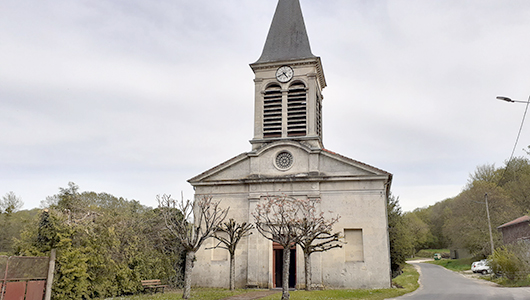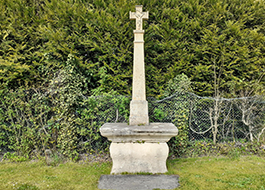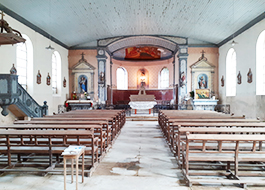Valbois
Durée visite : 30 minutes
Moyen : Pédestre
Valbois résulte de la fusion de trois communes, Varvinay, Savonnières-en-Woëvre et Senonville. On y trouve les traces d’une voie romaine à proximité. Des sarcophages de l’époque mérovingienne y ont été découverts. En 1497, le duc René II abandonne la seigneurie à Gérard d’Avillers, à charge de la restaurer. En 1766, les trois villages deviennent français, par le rattachement de la Lorraine à la France. Au XIXe siècle. les femmes des trois localités pratiquent la broderie, tandis que les hommes sont scieurs de long. Le village abrite aussi un moulin, un équarrissage et une huilerie . On y pratique la culture du chanvre. Senonville vit aussi de l’extraction de la pierre. En septembre 1914, les trois villages sont occupés par les Allemands. Ils séquestrent les habitants dans l’église de Varvinay, puis les déportent en Allemagne. Varvinay, Savonnières-en-Woëvre, Senonville sont détruits durant la Première Guerre mondiale. Ils sont tous trois décorés de la croix de guerre, avec citation à l’ordre de l’armée. Ils fusionnent en 1972 pour former la commune de Valbois.
Valbois results from the merger of three municipalities, Varvinay, Savonnières-en-Woëvre and Senonville. There are traces of a nearby Roman road. Sarcophagi from the Merovingian period have been discovered there. In 1497, Duke René II abandoned the seigniory to Gérard d’Avillers, in charge of restoring it. In 1766, the three villages became French, by the attachment of Lorraine to France. In the nineteenth century. the women of the three localities practice embroidery, while the men are pit sawyers. The village is also home to a mill, rendering and oil mill. Hemp is grown here. Senonville also lives from the extraction of stone. In September 1914, the three villages were occupied by the Germans. They sequester the inhabitants in the church of Varvinay, then deport them in Germany. Varvinay, Savonnières-en-Woëvre, Senonville were destroyed during the First World War. They are all three decorated with the Croix de Guerre, with mention in the order of the army. They merged in 1972 to form the commune of Valbois.
Valbois entsteht aus dem Zusammenschluss der drei Gemeinden Varvinay, Savonnières-en-Woëvre und Senonville. Es gibt Spuren einer nahegelegenen Römerstraße. Dort wurden Sarkophage aus merowingischer Zeit entdeckt. 1497 überließ Herzog René II. die Herrschaft Gérard d’Avillers, der mit der Restaurierung beauftragt wurde. 1766 wurden die drei Dörfer durch die Angliederung Lothringens an Frankreich französisch. Im neunzehnten Jahrhundert. Die Frauen der drei Orte üben Stickereien aus, während die Männer Grubensäger sind. Das Dorf beherbergt auch eine Mühle, eine Tierkörperverwertung und eine Ölmühle. Dort wird Hanf angebaut. Auch Senonville lebt vom Steinabbau. Im September 1914 wurden die drei Dörfer von den Deutschen besetzt. Sie sperren die Einwohner in der Kirche von Varvinay ein und deportieren sie dann nach Deutschland. Varvinay, Savonnières-en-Woëvre, Senonville wurden im Ersten Weltkrieg zerstört. Sie sind alle drei mit dem Croix de Guerre geschmückt, mit Erwähnung im Orden der Armee. Sie schlossen sich 1972 zur Gemeinde Valbois zusammen.
Les points de visites
.
Cette croix est décoré d’un christ sculpté. Ce supplice romain est souvent mal représenté. En effet, au XXe siècle, des recherches ont montré que les clous étaient fixés dans les poignets, non dans les mains. Un unique clou transperçait les pieds reposant l’un sur l’autre.
This cross is decorated with a sculpted Christ. In the 20th century, research showed that the nails were fixed in the wrists, not in the hands. A single nail pierced the legs resting on top of each other.
Dieses Kreuz ist mit einem gemeißelten Christus verziert. Im 20. Jahrhundert zeigte die Forschung, dass die Nägel in den Handgelenken befestigt waren, nicht in den Händen. Ein einzelner Nagel durchbohrte die übereinander liegenden Beine.
.
.
Elle date de 1840. L’église de Varvinay ( ancien nom de Valbois) est célèbre du fait de la diffusion d’une carte postale allemande, rééditée par les Français avec la légende :
Ceux que les Allemands appellent sans asile, ce sont les habitants qu’ils ont enlevés de leurs demeures et emprisonnés dans les églises.
Elle montre en 1914 les réfugiés du secteur. Ils sont enfermés sous la surveillance d’un soldat allemand. En septembre 1914, les civils des villages occupés sont systématiquement regroupés puis enfermés dans les églises, avant d’être déportés en Allemagne. Celle de Varvinay, qui accueille les réfugiés de la contrée, est plusieurs fois touchée par les tirs d’artillerie. En effet, les forts des Paroches et de Troyon bombardent les installations et abris allemands. Ceux-ci sont disséminés sur les versants du haut du village. L’église fait l’objet d’une restauration en 1920.
It dates from 1840. The church of Varvinay is famous because of the distribution of a German postcard, reissued by the French with the caption:
Those whom the Germans call without asylum are the inhabitants whom they have removed from their dwellings and imprisoned in the churches.
It shows in 1914 the refugees of the sector. They are locked up under the supervision of a German soldier. In September 1914, civilians from occupied villages were systematically rounded up and then locked up in churches, before being deported to Germany. That of Varvinay, which accommodates the refugees of the region, is several times affected by artillery fire. Indeed, the forts of Paroches and Troyon bombed the German installations and shelters. These are scattered on the upper slopes of the village. The church was restored in 1920.
Sie stammt aus dem Jahr 1840. Die Kirche von Varvinay ist berühmt wegen der Verteilung einer deutschen Postkarte, die von den Franzosen neu aufgelegt wurde mit der Überschrift:
Diejenigen, die die Deutschen ohne Asyl anrufen, sind die Einwohner, die sie aus ihren Wohnungen vertrieben und in den Kirchen eingesperrt haben.
Es zeigt 1914 die Flüchtlinge des Sektors. Sie werden unter der Aufsicht eines deutschen Soldaten eingesperrt. Im September 1914 wurden Zivilisten aus besetzten Dörfern systematisch zusammengetrieben und anschließend in Kirchen eingesperrt, bevor sie nach Deutschland deportiert wurden. Das von Varvinay, das die Flüchtlinge der Region beherbergt, wird mehrmals von Artilleriefeuer getroffen. Tatsächlich bombardierten die Forts von Paroches und Troyon die deutschen Einrichtungen und Unterstände. Diese sind an den oberen Hängen des Dorfes verstreut. Die Kirche wurde 1920 restauriert.







